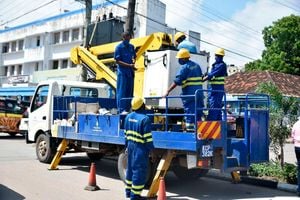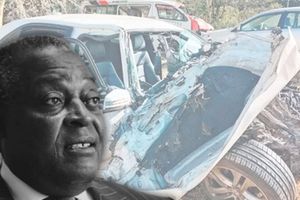
A dark Kisumu street in a past power blackout.
Erratic power supply across the country and poor infrastructural distribution are causing massive losses for traders and curtailing most Kenyans from achieving their potential.
From outages that take weeks to fix to areas totally overlooked by the country’s sole power distributor, Kenya Power, it is dim everywhere you look as far as the country’s electricity supply is concerned.
Kisumu
A recent electrocution incident in Kisumu is an illustration of how wrong things can go when there is an unreliable power supply for businesses.
On February 12, trader Jeremiah Osiri, was electrocuted in Kisumu’s Manyatta Estate. Mr Osiri who operated a barbershop around Kosawo Social Hall met his death while trying to restore power supply.
According to witnesses, Osiri – who was also a part-time electrician – was pushed to his death by frustration over frequent power outages in the area that severely affected his trade.
Out of desperation, Mr Osiri, went out of his way to rig a solution by reconnecting his line but did not live to tell the story.
In the lakeside town, the areas worst-hit by power outages are situated along Mosque-Corner Mbuta road, the Sky-way-Kosawo Primary School road and the Corner Mbuta-Corner Maji road.
Most residents don’t even have an issue with the blackouts if it were not for the duration it usually takes to restore power supply. Sometimes it takes days, weeks and months.
For instance, a transformer exploded next to Kosawo Primary School around the first week of January. It took almost a month for the issue to be rectified.
Siaya
In Alara village in North Alego Ward, Siaya County, some homes have had no electricity since August 2023.
At first, four electric poles fell in the home of Emmanuel Agutu. Despite numerous calls and visits to the Kenya Power offices, Mr Agutu said he never got help and feedback from the power supplier.
“We heard reports that a transformer had exploded and would be fixed before the poles were put back up. We devised our own ways of erecting the poles around December but six months later the transformer is yet to be repaired,” said Mr Agutu.
The outage has affected an entire village in the Kobare area and its impact is already being felt following a spate of insecurity in the environs.
Nakuru
In Nakuru, a farmer recounted the huge losses he has suffered due to erratic power supply.
Mr Joseph Njuguna alias Kimani wa Kimani, a poultry farmer, has been using electric-powered incubators to hatch eggs.
He revealed that he has thrice in the past suffered losses due to frequent electricity outages at his farms in Maili Sita and St Mary’s in Nakuru.
“On August 26, last year, I lost more than 5,132 hatching eggs due to a power outage that lasted nearly eight hours. It was a big blow,” said Mr Kimani.
Mr Kimani said he suffered losses three times last year due to the electricity blackouts.
“On one occasion, l lost a load of another 1,056 eggs, which were almost hatching,” he said.
Artificial egg incubators ought not to go without power for more than six hours. “Whenever there is a blackout lasting six to eight hours. My loss of 5,000 last year was very costly blow given that it was my entire investment that time,” he said.
Due to the frequent blackouts, Mr Kimani has been seeking alternatives, including use of kerosene egg incubator technology.
Maralal
In Maralal, Samburu Business Community Chairman Moses Lenairoshi said businesspeople have been counting losses over abrupt power interruptions.
The growing power supply crisis, Mr Lenairoshi said, is threatening growth in the town.
“It is a major threat to the county’s economy. Frequent unannounced power outages always deal a major blow to the business community in this town,” said Mr Lenairoshi.
Salons, barbershops, cyber cafes, photocopying bureaus, and petrol stations are the most affected. “Everyone is hit by this crisis and burglars are taking advantage,” he added.
In June last year, Samburu Governor Jonathan Lelelit threatened to sue Kenya Power for causing irrevocable damage to locals and institutions following frequent fires suspected to be as a result of electrical faults.
But the KP officials say the frequent outage in Maralal was being caused by faults in the main line, which starts in Lanet, Nakuru County.
Kisii
In Bobaracho village of Nyaribari Chache Constituency, Kisii County, 26-year-old Brian Babu who operates a barbershop decries the incessant power outages.
Having finished school seven years ago and with no formal job available, he started a barbershop to sustain himself and his two siblings.
But his business is frequently interrupted by power outages, leading to huge losses.
“There are times we go for up to a whole week without supply, yet I pay rent for the space where the barbershop is. What irritates me most is that sometimes you find that while we are in darkness, neighbouring villages are enjoying steady power supply,” Babu said.
Meru
In Imenti, Meru County, residents have been forced to connect power illegally due to a bottleneck they are unable to overcome.
One of the conditions for installation of electricity by Kenya Power is that a transformer is installed within the compound of an institution like a school or a dispensary and it should serve a radius of 600 metres. This means that homes that are far from these institutions cannot be connected to electricity, a situation that has befallen many villages across the county.
Some of the most affected areas are in Imenti Central and Imenti South. Popularly known as “islands”, these areas are surrounded by neighbours who have electricity in their homes yet they remain in the darkness, with residents terming this marginalisation and discrimination.
The situation has resulted in residents devising ways of being connected to power, with some defying rules and connecting electricity illegally, saying they cannot remain in darkness while their neighbours enjoy power. This has, in turn, bred cartels operating between Kenya Power and the residents.
Mr Jackson Mitriti, a resident of Kionyo in Imenti South, said once an area has been left out in the official power distribution, people contribute money and pay these cartels who connect them to power.
“Those who make the connections are well known to Kenya Power engineers and they even have the necessary equipment. What you need to do is just contribute money as a group and pay them,” Mr Miriti said.
Turkana
In Turkana, the frequent blackouts led to the filing of a court case last year.
Mr Shadrack Muyesu, a Lodwar resident and an advocate of the High Court, cited Kenya Power, the Kenya Electricity and Transmission Company and the Attorney-General over unreliable power supply where residents are subjected to a “guessing game in anticipation of the next blackout”.
He argued that around September 5 last year, Lodwar town and its environs started experiencing a prolonged series of unexplained power blackouts which compelled him to seek an explanation for the occurrence and the steps being taken to mitigate against it.
“While it is trite industry (practice) for Kenya Power to issue a notice of interruption to supply prior to the interruption, no such notice was served upon the people of Turkana, let alone in good time as the law demands prior to the blackouts. Instead, they continue to be subjected to frequent, prolonged and unexpected power interruptions,” he said.
He also wondered why the larger Turkana County is yet to be connected to the national grid five many decades after independence, saying it was proof of discriminatory policies. He has, however, since withdrawn the case.
The issue of Turkana being in the dark yet it hosts power generation infrastructure was raised by the county’s Senator James Lomenen during a Senate Mashinani session held in September last year, when he also raised concerns about persistent blackouts in power generation hubs like Lodwar and Loima.
The legislator sought an explanation as to why these areas continue to experience unreliable power supply.
“It’s a paradox. The Turkwel Hydroelectric Power Station and Lake Turkana Wind Power stand nearby, yet other parts of the country enjoy power sourced from here. We, on the other hand, remain in darkness,” he said.
Energy CS Davis Chirchir, in response, said that the problem – which is yet to be addressed – stemmed from a malfunctioning generator, rendering it incapable of meeting the power demands of the region.
Bomet
In Bomet, traders who have incurred losses over frequent power blackouts have demanded an urgent solution.
Mr Leonard Langat, who runs a chain of businesses in hospitality, transport and fuel, said power supply that has for the past several months become erratic has forced him to lay off workers due to losses incurred.
“The Jua Kali sector has been affected, with welders unable to meet their customers’ demands due to frequent power outages. Those of us in the hospitality industry have been forced to use firewood and gas for cooking while clients booked into hotels have to make do with cold showers,” Mr Langat said.
Reporting by Rushdie Oudia, Eric Matara, Geoffrey Ondieki, Wycliffe Nyaberi, Gitonga Marete, Sammy Lutta and Vitalis Kimutai










